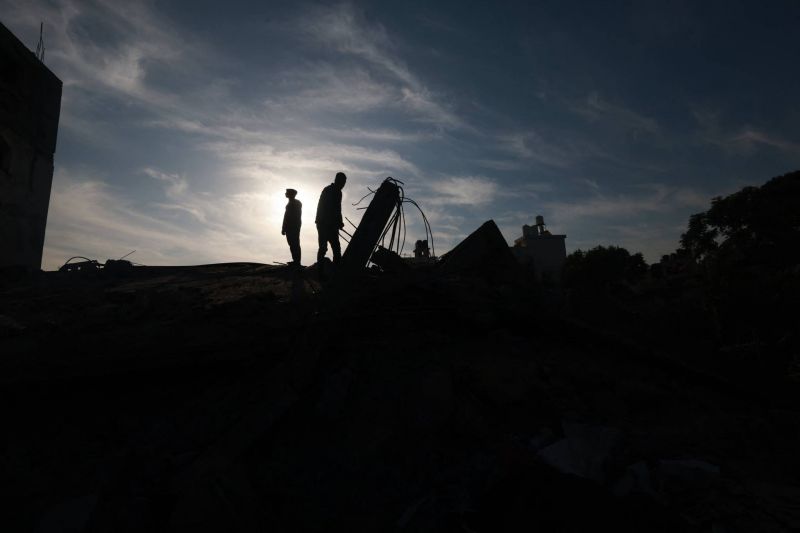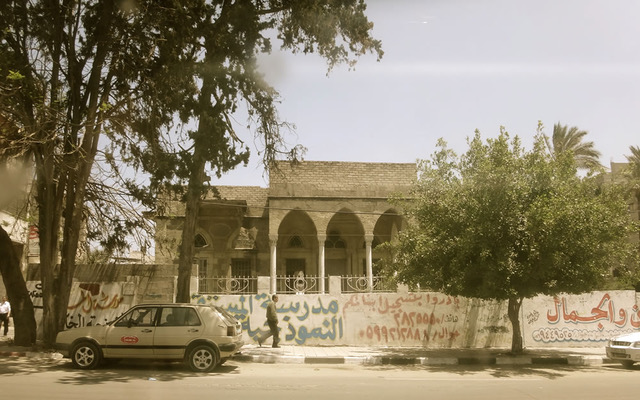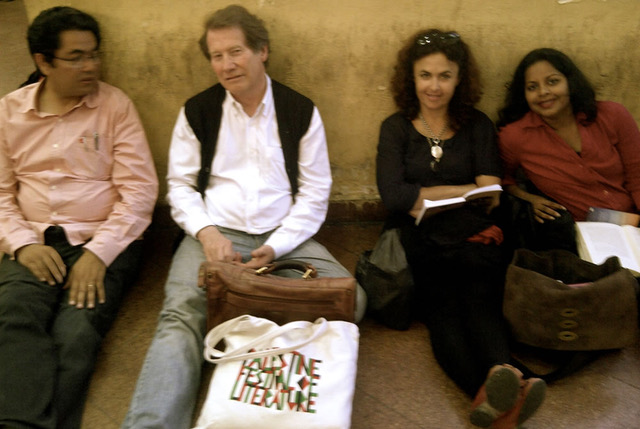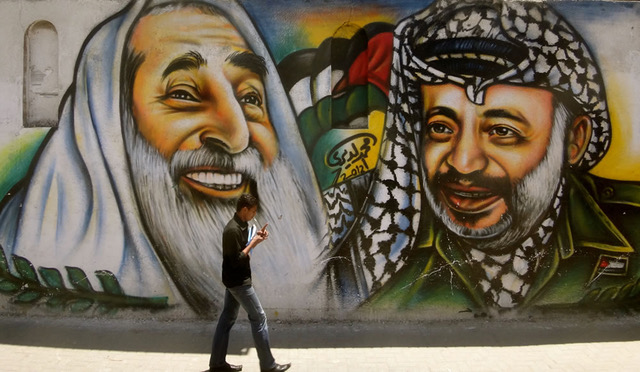
Palestinians inspect the damage in a residential area in Rafah in the southern Gaza Strip, following Israeli air strikes early on Dec. 4, 2023. (Credit: Mohammed Abed/AFP)
It’s akin to wearing a Google Glass; images are replayed in front of your eyes as though projected from a screen, even when I’m not looking at my phone anymore. The ones flickering across my Instagram feed at present are of an elegant young woman talking to her camera. She stands against a white wall and has a black scarf around her head. It’s a short video, a crisp, professional account. The words — “they dropped white phosphorous and sound bombs on Beit Lahya,” “everyone running like mad men, they know not where,” “they are dropping leaflets telling us to evacuate,” “I cannot describe,” “I have lost my people,” “I don’t know where they are,” “I am staying,” “May God Have Mercy On Us” — are some of her last.
Her name is Ayat Al Khadour. She was a journalist and that was her final video. She was one of more than 50 journalists killed in Gaza since Oct. 7. Her post does not have so many likes on Instagram, relatively speaking. I click “like,” but what is there to like? It is two steps away from being a snuff video, but I want it to go viral. I want it broadcast in Times Square. I want it playing on a loop in the Knesset, the White House, the Houses of Parliament, in the lobbies of all of the arms manufacturers. I want a monument to Ayat Al Khadour on the scale of the Statue of Liberty, higher than Nelson’s Column.
 An Ottoman-era building in Gaza during the author's trip to the city in 2012. The building is said to have been destroyed since then. (Credit: Selma Dabbagh)
An Ottoman-era building in Gaza during the author's trip to the city in 2012. The building is said to have been destroyed since then. (Credit: Selma Dabbagh)
The next image that plays before my eyes is more colorful. Blue bags in brown sand. An art installation piece for the Biennale maybe? What am I looking at here after the sponsored advertisement for a new kind of garlic crusher? Blue bags, many, of various sizes, lined up and tied like portions of leftovers about to go in the freezer. They have hurried scribbles on them, scratched in marker. Not enough to identify them by. A long, mass grave of more than a hundred people. “Bodies from the Al Shifa hospital,” says the caption, the details of genocidal aggression reaching me through the lens of social media. After these bodies, there is an advertisement for stomach exercises before the same image comes up again from a different media outlet. Mass graves. No chance for parents to find their children, for children to find their parents. No chance for anyone to find Ayat Al Khadour if she is there. Unnamed, unmarked, together.
Sixty-one days in, and a “humanitarian pause” has come and gone.” Not necessarily a ceasefire. Just a pause. “It is like they’re fattening them up before they bomb them again,” said an English friend, who I have never much aligned with politically. She’s walking with me and my parents in a London demonstration with her daughter. She’s never been in a demonstration before and keeps asking me questions about how it works. The rules are simple, really: you walk, occasionally you chant “In Our Tens In Our Millions, We are All Palestinians.” You just have to be. Anguished, unarmed, together.
 The author and colleagues wait at the Rafah crossing during a trip to Gaza in 2012 as part of the Palestinian Festival of Literature. (Credit: Selma Dabbagh)
The author and colleagues wait at the Rafah crossing during a trip to Gaza in 2012 as part of the Palestinian Festival of Literature. (Credit: Selma Dabbagh)
I last went to Gaza 10 years ago. Our bus arrived at night. The blackout made it feel cozy and secretive, a land from another era. We drove along the coast with the moon hanging over graveyards that slid into the sea. Like a walled garden, I thought. We were in a group with the Palestinian Festival of Literature (PalFest) and we became known as the Egyptian delegation. The Egyptian revolution was still going strong and the Tahrir band Eskanderella was with us, as was the writer/blogger Alaa Abd El-Fattah, who is today imprisoned in Cairo. We were visiting at a time that had signs of hope for Gaza. Winds of change blowing in from Egypt. Optimistic, creative, together.
The first time I visited Gaza was not with an Egyptian delegation but with a Norwegian one. It was in the 1990s and two Norwegians from the West Bank took me down to visit for the day. You could easily do that then. I was not in favor of the Oslo agreements, but the Norwegians with me were, and so was their man, career diplomat Torje-Rod Larson, whom we saw briefly; blonde and triumphant standing on a roof looking out to sea. His daily schedule, which included running, I recall, was relayed to me with pride by his compatriots. There was a feeling, again, of expectation and hope.
 Street art in Gaza, photographed by the author during a visit in 2012 as part of the Palestinian Festival of Literature. (Credit: Selma Dabbagh)
Street art in Gaza, photographed by the author during a visit in 2012 as part of the Palestinian Festival of Literature. (Credit: Selma Dabbagh)
I visited Gaza a couple of years later, when I was married. My then-husband and I, both of us British of Palestinian heritage, both lawyers who worked in human rights, had ideas about returning to this new Palestine that was being built in Gaza. There were schemes run by the United Nations Development Programme that were encouraging qualified Palestinians from the diaspora to return. It was good to see our friends in Gaza, some of whom had moved there recently, whom I had rarely heard speak of anything but enraged politics previously, now commenting on domestic arrangements, the color of cushions. Politicized, affectionate, together.
That was a brief respite, a false dawn. Oslo prepared the groundwork for the mass criminality that we are experiencing today. Since they were signed, the Israeli settler population in the West Bank has increased by 332 percent.
More land, fewer people. The Oslo agreements are not being honored by the Israeli government and are deeply unpopular among Palestinians. Rather, they are another stick to beat the Palestinians with — we tried, the Israelis say, to negotiate, but you know, it is impossible. The Palestinians apparently only understand violence. On the subject of violence, Israel is, I would like to mention here, the only country in the world that systematically prosecutes children in military courts — between 500 to 700 each year. An average of 204 Palestinian children have been held in custody every month since 2012. In recent weeks, 6,000 bombs per week have been dropped on Gaza.
Gaza is a sealed rectangle of coast just six to 12 km wide and 25 km long. More than half of its population is under the age of 18. I have worked for organizations documenting these alleged war crimes, challenging these violations of international law, in the hopes that, someday, the victims can find justice. Informed, committed, together.
Selma Dabbagh is a writer of fiction, an editor and a lawyer. Her novel “Out of It” (Bloomsbury, 2011) was mainly set in Gaza.